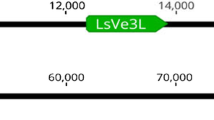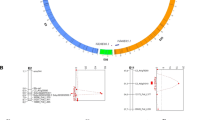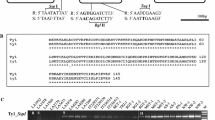Abstract
As a step toward greater understanding of the genetics of verticillium wilt resistance in plants, we report the sequencing of a candidate wilt resistance gene, mVe1, from the mint diploid model species, Mentha longifolia (Lamiaceae). mVe1 is a putative homolog of tomato (Solanum lycopersicum L.) verticillium wilt (Ve) resistance genes. The mVe1 gene has a coding region of 3,051 bp. The predicted mVe1 protein contains a leucine-rich repeat domain, a common feature of plant disease resistance proteins. We compared 13 mVe1 alleles from three mint species. These alleles shared 96.2–99.6% nucleotide identity. We analyzed four M. longifolia populations segregating with respect to mVe1 alleles and wilt resistance versus susceptibility and found one association between mVe1 genotype and wilt phenotype. We conclude that mVe1 may play a role in mint verticillium wilt resistance, but variation for resistance in our segregating progenies is likely polygenic. Therefore, further investigations of mVe1 and identification of additional candidate genes are both warranted.









Similar content being viewed by others
References
Alexander LJ (1962) Susceptibility of certain verticillium-resistant tomato varieties to an Ohio isolate of the pathogen. Phytopathology 52:998–1000
Arbogast M, Powelson ML, Cappaert MR, Watrud LS (1999) Response of six potato cultivars to amount of applied water and Verticillium dahliae. Phytopathology 89(9):782–788
Berry SZ, Thomas CA (1961) Influence of soil temperature, isolates, and method of inoculation on resistance of mint to verticillium wilt. Phytopathology 51(3):169–174
Chai Y, Zhao L, Liao Z, Sun X, Zuo K, Zhang L, Wang S, Tang K (2003) Molecular cloning of a potential Verticillium dahliae resistance gene SlVe1 with multi-site polyadenylation from Solanum licopersicoides. DNA Seq 14(5):375–384
Fei J, Chai Y, Wang J, Lin J, Sun X, Sun C, Zuo K, Tang K (2004) cDNA cloning and characterization of the Ve homologue gene StVe from Solanum torvum Swartz. DNA Seq 15(2):88–95
Harley RM, Brighton CA (1977) Chromosome numbers in the genus Mentha L. Bot J Linn Soc 74:71–76
Hu G, de Hart AKA, Li Y, Ustach C, Handley V, Navarre R, Hwang C-F, Aegerter BJ, Williamson VM, Baker B (2005) EDS1 in tomato is required for resistance mediated by TIR-class R genes and the receptor-like R gene Ve. Plant J 42(3):376–391
Kawchuk LM, Hachey J, Lynch DR, Kulcsar F, van Rooijen G, Waterer DR, Robertson A, Kokko E, Byers R, Howard RJ, Fischer R, Prufer D (2001) Tomato Ve disease resistance genes encode cell surface-like receptors. Proc Natl Acad Sci USA 98(11):6511–6515
Kozak M (1986) Point mutations define a sequence flanking the AUG initiator codon that modulates translation by eukaryotic ribosomes. Cell 44(2):283–292
Lacy ML, Horner CE (1965) Verticillium wilt of mint: interactions of inoculum density and host resistance. Phytopathology 55(11):1176–1178
Lange BM, Wildung MR, Stauber EJ, Sanchez C, Pouchnik D, Croteau R (2000) Probing essential oil biosynthesis and secretion by functional evaluation of expressed sequence tags from mint glandular trichomes. Proc Natl Acad Sci USA 97(6):2934–2939
Liu Y-G, Whittier RF (1995) Thermal asymmetric interlaced PCR: automatable amplification and sequencing of insert end fragments from P1 and YAC clones for chromosome walking. Genomics 25(3):674–681
Liu Y-G, Mitsukawa N, Osumi T, Whittier RF (1995) Efficient isolation and mapping of Arabidopsis thaliana T-DNA insert junctions by thermal asymmetric interlaced PCR. Plant J 8(3):457–463
Sargent D, Davis TM, Tobutt K, Wilkinson M, Battey N, Simpson D (2004) A genetic linkage map of microsatellite, gene specific and morphological markers in diploid Fragaria. Theor Appl Genet 109:1385–1391
Schaible L, Cannon OS, Waddoups V (1951) Inheritance of resistance to verticillium wilt in a tomato cross. Phytopathology 41(10):986–990
Seah S, Telleen AC, Williamson VM (2007) Introgressed and endogenous Mi-1 gene clusters in tomato differ by complex rearrangements in flanking sequences and show sequence exchange and diversifying selection among homologues. Theor Appl Genet 114(7):1289–1302
Simko I, Costanzo S, Haynes KG, Christ BJ, Jones RW (2004a) Linkage disequilibrium mapping of a Verticillium dahliae resistance quantitative trait locus in a tetraploid potato (Solanum tuberosum) through a candidate gene approach. Theor Appl Genet 108(2):217–224
Simko I, Haynes KG, Jones RW (2004b) Mining data from potato pedigrees: tracking the origin of susceptibility and resistance to Verticillium dahliae in North American cultivars through molecular marker analysis. Theor Appl Genet 108(2):225–230
Sink KC, Grey WE (1999) A root-injection method to assess verticillium wilt resistance of peppermint (Mentha xpiperita L.) and its use in identifying resistant somaclones of cv. Black Mitcham Euphytica 106(3):223–230
Thompson JD, Gibson TJ, Plewniak F, Jeanmougin F, Higgins DG (1997) The ClustalX windows interface: flexible strategies for multiple sequence alignment aided by quality analysis tools. Nucleic Acids Res 25:4876–4882
Tucker AO, Naczi RFC (2005) Mentha: an overview of its classification and relationships. In: Lawrence BM (ed) Mints: the genus Mentha. Taylor & Francis, London
Vallad GE, Subbarao KV (2008) Colonization of resistant and susceptible lettuce cultivars by a green fluorescent protein-tagged isolate of Verticillium dahliae. Phytopathology 98(8):871–885
van der Hoorn RAL, Roth R, De Wit PJGM (2001) Identification of distinct specificity determinants in resistance protein Cf-4 allows construction of a Cf-9 mutant that confers recognition of avirulence protein AVR4. Plant Cell 13(2):273–285
Veronese P, Narasimhan ML, Stevenson RA, Zhu JK, Weller SC, Subbarao KV, Bressan RA (2003) Identification of a locus controlling Verticillium disease symptom response in Arabidopsis thaliana. Plant J 35(5):574–587
Vining KJ, Zhang Q, Smith CA, Tucker AO, Davis TM (2005) Mentha longifolia (L.) L.: a model species for mint genetic research. Hort Sci 40(5):1225–1229
Vining KJ, Zhang Q, Smith CA, Davis TM (2007) Resistance gene analogs and Verticillium resistance-like sequences from Mentha longifolia. J Am Soc Hort Sci 132(4):541–550
Acknowledgments
We thank Estelle Hrabak and Dennis Mathews for their careful manuscript reviews and helpful comments. This is New Hampshire Agricultural Experiment Station (NHAES) contribution #2370. This work was supported by NHAES grant NH0433 and by the Mint Industry Research Council.
Author information
Authors and Affiliations
Corresponding author
Additional information
Communicated by S. Hohmann.
Rights and permissions
About this article
Cite this article
Vining, K., Davis, T. Isolation of a Ve homolog, mVe1, and its relationship to verticillium wilt resistance in Mentha longifolia (L.) Huds. Mol Genet Genomics 282, 173–184 (2009). https://doi.org/10.1007/s00438-009-0454-6
Received:
Accepted:
Published:
Issue Date:
DOI: https://doi.org/10.1007/s00438-009-0454-6




